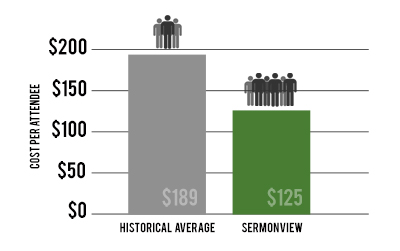The world has changed. Evangelism marketing practices that worked in decades past don’t work the way they used to. By using the tried and true methods of days gone by we leave ourselves destined for diminishing returns. Our best efforts never yield the same results, and many are asking the existential question: Does evangelism even work anymore? But I believe that’s the wrong question. The better question is:
What has changed in this post-modern world? And how do we change our evangelistic methods to adapt?
The fact is, today’s generations are savvy audiences. They can smell hype a mile away, and they can distinguish between reality and hyperbole. They can sense when something is too good to be true.
This means that to be effective in today’s world, evangelism marketing requires an honest approach mixed with an intriguing storyline. You have to compel interests into action, provoking people to leave the comfort of their recliners. But how do we build this level of action without hype or mystery?
We use redundant honesty.
Mystery is no longer the strongest draw. Trick titles, vague suggestions, and confusing images no longer pull a crowd. Straightforward honesty about relevant topics, paired with compelling visuals relevant to today’s culture, is the best way to encourage participation. Of course we need to create interest, but obfuscation does not lead to curiosity. We need to help people understand what they are attending.
This is why effective evangelism marketing is so different today. We need to spot trends and shifts in what people react to, and how they respond. This allows us to craft an authentic message that encourages maximum response in a community.
Redundant honesty is a communication strategy where we approach the interest with transparency and consistency. We focus on the things they do understand, and use that to get them curious about things that they don’t yet understand. This connects us to the audience and speaks to the felt-needs of those you are trying to reach. There is no hype, only truth—a truth that sets people free.
The good news is that there are people in the world who are trained to keep a finger on the pulse of culture, finding ways to leverage this changing culture to communicate more effectively. These people are called marketers. And a few of us even focus on evangelism marketing. These are professionals you can turn to, who will do the heavy lifting of an effective evangelism marketing campaign.
When you’re ready to plan your next evangelistic campaign, here are five things that you should expect your evangelism marketing team to do for you:
- Evaluate demographics. This is both art and science. Marketers will start by looking at income levels, age, and ethnicity. But today they also look at voting records, education levels, ratio of homes with children, and traffic patterns to make sure that the audience and the message are tightly integrated. The Direct Marketing Association suggests that proper list management can increase response rates three-fold. Since it is more cost-effective for a local church to saturate a mailing area, the key is to use demographic analysis to determine which carrier routes are best primed for the highest response.
- Plan a multi-channel campaign. By communicating your message through multiple channels, you increase response rates across the entire campaign. The question is, which channels should you use? And how much of your budget should be spent in each channel?Evangelism marketers know how to maximize the budget to get the best response. This is because there are a number of factors to consider in every campaign. Although direct mail is still your highest responding paid channel, its performance can be magnified with well-placed ads and signs. Knowing when and how to put the campaign together for maximum effectiveness is the job of your evangelism marketing team.
- Hone your message. This may be the best reason to use an evangelism marketing organization instead of just a printer. You’ll work closely with someone who helps you translate church-speak into language that reaches a broader audience. Everyone thinks in terms of their own experience, and many writing styles follow that course. What appears to make sense to a pastor, however, may not resonate with a young mother or a blue-collar factory worker. A good copywriter will help develop a storyline for your campaign that is consistent with the content—helping to ensure that your advertising is targeted to the correct audience.
- Create a release timeline. For everything to work together for maximum effectiveness, you need a timeline for each channel. The order of the marketing channels, from signage to mailers, social media to print, must be tactically planned to maximize the number of people walking through your doors. A good marketing team will help educate you on the role your ministry team plays in the marketing, while handling most of the workload themselves to protect your timelines.
- Track everything. If the goal of evangelism marketing is to find out how to reach the most receptive people in your community, then data mining is the key to discovery. By acquiring and evaluating data from every campaign, a good evangelism marketing team will uncover trends and determine best practices for churches across the country. The more comprehensive the data, the better the analysis. That allows the entire evangelism community to better understand what works in today’s culture, and to quickly adapt to cultural shifts.
Nearly every Seventh-day Adventist church in North America has active members who came to know Jesus through public evangelism. Evangelistic campaigns continue to be effective at introducing people to the core truths of the church, while beginning to integrate them into the life of the church. A healthy church will include public evangelism in its outreach diet.
When done right, an evangelism marketing campaign will draw people to your event that would not have otherwise come. But the world has changed. Your evangelism marketing methods need to change, too. Working with experienced evangelism marketing professionals will help you make the right changes, increasing your response rate and drawing more people through the doors of your church.
Larry Witzel is founder and president of SermonView, an evangelism marketing ministry that has served thousands of churches throughout North America. Learn more at EvangelismMarketing.com.



 “Evangelism isn’t dead!” exclaimed Dr. Roger Walter, senior pastor of the Vancouver, Wash., church. “I still believe that Adventist churches grow differently.”
“Evangelism isn’t dead!” exclaimed Dr. Roger Walter, senior pastor of the Vancouver, Wash., church. “I still believe that Adventist churches grow differently.”
 Okay, so what get’s you a better response rate? Answer: higher quality marketing.
Okay, so what get’s you a better response rate? Answer: higher quality marketing.


 “I tell you, I’m not an evangelist!” said Eugene Prewitt, pastor of the Arkadelphia 61-member church. “I haven’t been trained for evangelism, but there’s a desire in me to do this kind of work.”
“I tell you, I’m not an evangelist!” said Eugene Prewitt, pastor of the Arkadelphia 61-member church. “I haven’t been trained for evangelism, but there’s a desire in me to do this kind of work.”
 The year 2014 has been a breakthrough year for evangelism marketing at SermonView. After 5 years of some success, grinding it out and learning from our mistakes, we suddenly found a marketing focal point that worked better than anything we’d ever seen. As we honed these discoveries over the following months, we consistently saw handbill mailings with double, triple and even quadruple the previous response rates. It has been truly astonishing.
The year 2014 has been a breakthrough year for evangelism marketing at SermonView. After 5 years of some success, grinding it out and learning from our mistakes, we suddenly found a marketing focal point that worked better than anything we’d ever seen. As we honed these discoveries over the following months, we consistently saw handbill mailings with double, triple and even quadruple the previous response rates. It has been truly astonishing.